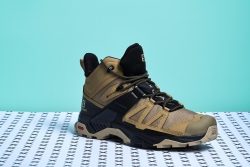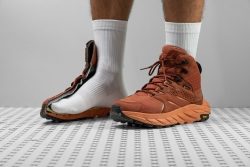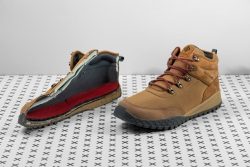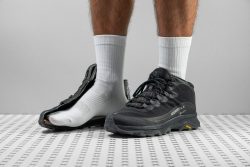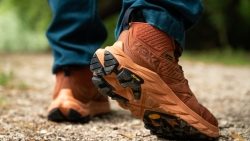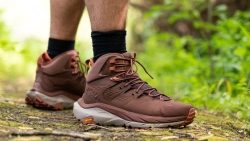7 Best Lightweight Waterproof Hiking Boots in 2024
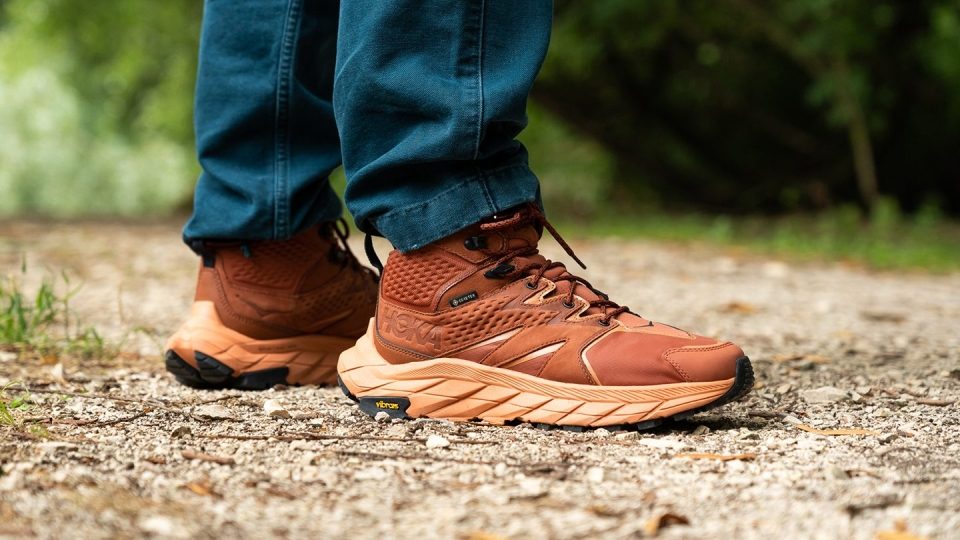
It’s about time to switch from your clunky boots to these top-rated lightweight kicks. Utilizing innovative concepts and technological advances in boot-making, giant footwear brands like Lowa, Salomon, Merrell, Adidas, and Columbia released their highly regarded lightweight waterproof hiking boots.
If you’re like many outdoor enthusiasts who prefer to shed off unwanted poundage on the trail, then you will definitely love the Innox Pro from Lowa built for backpackers, or the X Ultra series from Salomon. There’s actually a solid range of really good choices that we see in this category.
Picking the perfect pair for you can be time-consuming. We can help you with that! Since we personally wore the boots during our hikes, we already got a feel for each of them. And we properly tested them in our lab on our standardized tests. Therefore, our reviews are not baseless. With that, we give you our in-depth reviews and top rankings of lightweight waterproof hiking boots.
How we test hiking boots
We combine our very own experiences with our findings at the RunRepeat shoe testing lab. After carefully analyzing each boot inside the lab, we take the lightweight boots on actual hiking excursions and backpacking trips.
Before publishing our reviews and rankings, we do the following:
- We purchase lightweight waterproof hiking boots from various brands. We invest our own funds to maintain the objectivity of our reviews and rankings.
- We go for day hikes or long-distance treks covering 30+ miles for each pair of boots. We test the footwear’s performance, comfort, traction, waterproofness, durability, and reliability in different kinds of terrain.
- We get more useful information from our lab tests, which also entail the dissection of the shoes.
Best lightweight waterproof hiking boots overall














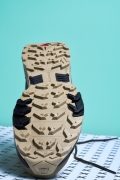





What makes it the best?
Tighten your shoelaces - we’ve found a winner for the best lightweight waterproof hiking boot! It kept us dry, protected and supported on our long hikes, and packs a lot into a featherweight package. At just 13.8 oz (390g), this boot is a whopping 5.7 oz (163g) lighter than the average waterproof hiking boot, keeping our feet much fresher for longer.
Salomon’s unique support system kept our feet firmly locked into the boot, even over rocky and uneven terrain. The lockdown is in part due to the normal laces favored by the X Ultra 4 Mid GTX, which we found more suitable for putting in long distances. As always, we are massive fans of the Contragrip sole and its 5.1 mm deep lugs. The superb traction of this boot inspires trust in our feet, even when walking over loose scree.
In the lab, we tested the flexibility of the boot by bending it with a force gauge. At room temperature, it takes a mere 27.9N to flex to 90°. The average for hiking boots is 42.8N. The numbers don’t lie - this boot is seriously flexible! Out hiking, we noticed how nimble and agile it felt - we were definitely channeling mountain goat vibes! To top it all off, the waterproofing is second to none. The Gore-Tex membrane and full gusset on the tongue keep our feet bone dry, even when submerged in water for more than a minute.
We don’t recommend this boot for trailblazers who plan to spend a lot of time hiking on muddy trails. The relatively tightly-spaced lugs don’t shed mud easily, leading to slippage.
Pros
- The boot of choice for multi-day hikes
- Lightweight
- Waterproof
- Excellent grip
- Supportive midsole
- Detailed ground feel
- Great ankle support
- Protective
- Perfect lacing system
Cons
- Midsole may be thin for some
- Very stiff in colder climates
Lightweight waterproof hiking boots with the best cushioning











































What makes it the best?
A well-rounded boot with plenty of features to keep our feet safe and comfy on the hill, the Hoka Anacapa Mid GTX is our top choice for a lightweight waterproof hiking boot with the best cushioning. With rock-solid stability, exceptional grip and protection, and Gore-Tex lining, we can’t get enough of this lightweight boot!
The all-day comfort we experienced in this boot is in no small part due to the exceptional cushioning underfoot. The iconic Hubble heel delivers super-smooth landings and the EVA foam midsole absorbs impact like a pro. We pressed a durometer to the midsole to check for hardness, finding it measured a plush 22.5 HA. 19% softer than average, it’s no wonder this sumptuous midsole keeps our feet happy, mile after mile!
From boulder hopping to rough forest trails, this boot has traction in bucketloads. We measured the lugs to be 4.7 mm deep, 0.3 mm deeper than average. The curious goat-like lug patterning is slightly flexible, which allows for extra traction, just like our four-legged counterparts! A rubber toe bumper and an extra 2 mm of cushioning than the average both go a long way to protecting our feet when hiking over sharp rocks.
This boot is ready to brave the elements. The Gore-Tex lining kept our feet impeccably dry on river crossings, with the fully gusseted tongue keeping water from seeping through the upper. Just watch out for water creeping in over the low heel counter!
All in all, this boot surprised us on the scales. At just 15.4 oz (436g), it is 2.9 oz (82g) lighter than the average for all hiking boots, and 4.1 oz (117g) lighter than the average waterproof boot. It’s really no wonder our legs had energy to burn, even after our long hikes.
We measured the thickness of the outsole in the lab, finding it to be 2 mm thick, 0.8 mm thinner than average. This may not be the most hard-wearing outsole on the market, so we don’t recommend it to hikers who need a tough pair of boots for long-distance hikes.
Pros
- Top-notch waterproofing
- Very lightweight
- Generous and soft cushioning
- Reliable stability (with a light backpack)
- Wide platform
- Flexible forefoot
- Excellent grip
- Doesn't get too firm or stiff in cold
- Comfortable in-shoe feel
- Effective lacing system
- Sustainable materials
Cons
- Not supportive with heavy backpacks
- Upper lacks wear resistance
- Extended heel catches rocks and roots
- Not for wide feet
- Tricky to put on
Lightweight waterproof hiking boots with the best support
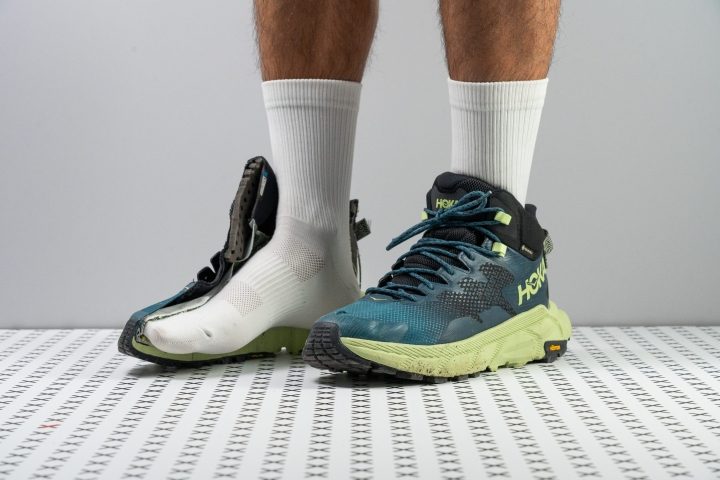


































What makes it the best?
The Hoka Trail Code GTX is what dreams are made of. It’s an astonishingly lightweight waterproof boot that has the stability of a hiking boot yet somehow feels as nimble as a running shoe! It completely won us over on our test hikes and in the lab, so we feel justified in calling the Hoka Trail Code GTX the most supportive lightweight waterproof hiking boot.
The multi-faceted support system in the Hoka Trail Code GTX is what makes it feel so incredibly stable. The high collar hugs our ankles, and the fairly rigid sole prevents us from twisting our ankles when hiking on uneven, rocky trails. We twisted the boot manually, awarding it 4/5 for torsional rigidity - among the stiffest boots to have passed through the lab! The heel counter fits snugly and holds our heel firmly into the boot. Our assessment confirmed it’s one of the stiffest heel counters, rating 5/5. Finally, the midsole measures 112.5 mm at the forefoot, which is the average for hiking boots. In short, it all adds up to a stable boot in which we feel confident and surefooted.
The Trail Code GTX is no match for puddles or stream crossings, and the Gore-Tex membrane and gusseted tongue keep our feet warm and dry, even on rainy days. A quick look at the boot’s upper under our microscope shows a high-quality, tightly-woven, water-resistant fabric that stops the water from getting in. Anything that makes it through will soon be stopped by the full Gore-Tex membrane. As if to prove the point, in our smoke test, which tests for breathability, the boot scored the lowest 1/5. If the smoke can’t get out, there’s no way water can get in!
Even with such high-performing waterproofing, this boot knocks the socks off the competition when it comes to weight. It tips our scales at 15.5 oz (440g), a staggering 20% lighter than the average waterproof hiking boots! Along with a midsole that is 60% more flexible than average, this boot does away with that cumbersome feel that we are accustomed to in a hiking boot. Our feet feel agile, yet supported by the collar and protected underfoot.
Hoka claims this boot has a low heel-to-toe drop of 6 mm, but our lab measurements found it to be 11.2 mm! We therefore don’t recommend it to hikers who prefer a low-drop boot for that natural hiking experience.
Pros
- Mind-blowingly comfortable
- Fantastic waterproofing
- Lighter than average
- Excellent impact protection
- Very stable and supportive
- Superb grip
- Reflective elements
- Sustainable materials
- Head-turning looks
Cons
- Awkward on descents
- Not for tough hikes
Best lightweight waterproof hiking boots for backpacking













































What makes it the best?
On our multi-day hikes, we lean towards a stable, supportive, and lightweight pair of boots - and if they are waterproof, so much the better. Incredibly, the La Sportiva Ultra Raptor II Mid GTX ticks all those boxes and more, leading us to choose it as our best lightweight, waterproof hiking boot for backpacking.
With a hard plastic shank embedded in the midsole, these boots are amongst the most rigid ever to have passed through our lab. After twisting and bending them, we awarded them a high rigidity score of 5/5. Coupled with a stiff heel counter, scoring a stiff 4/5, we experienced immense stability on our hikes, even over the most rugged and rocky terrain. This is good news for backpackers carrying heavy loads, as twisted ankles are out of the question.
La Sportiva have worked some sort of magic to keep the weight of these boots down. On the trail, our feet felt light and nimble, so back in the lab, we weighed them to put a number to the sensation. We were astounded to find these boots weigh a surprising 14.6 oz (415g), 18% less than average! They literally make light work of long hikes.
With a full Gore-Tex membrane, a high collar, and fully gusseted tongue, it’s hard for rain and stream water to get into this boot. A handy elastic mini-gaiter around the collar is the icing on the cake. In our smoke tests for breathability, we awarded it 1/5 - the least breathable score - which confirms our suspicions that this is a seriously waterproof hiker. We came back from our wet hikes and stream crossings with perfectly dry feet.
We don’t recommend this boot to beginner hikers. Our lab tests showed a midsole that measures 6.2 mm less than average at the forefoot and 7.5 mm less than average at the heel. Beginners and hikers who prefer a wider landing platform should look elsewhere.
Pros
- Unbelievably lightweight
- Excellent waterproofing
- Doesn't let debris and falling rain/snow inside
- Exceptionally robust and durable
- Phenomenal grip on technical terrain
- Not so stiff and firm in low temperature
- Great impact protection
- Highly supportive collar
- Ample flexibility
Cons
- Tight fit
- Narrow platform
Best lightweight waterproof hiking boots for speed hiking
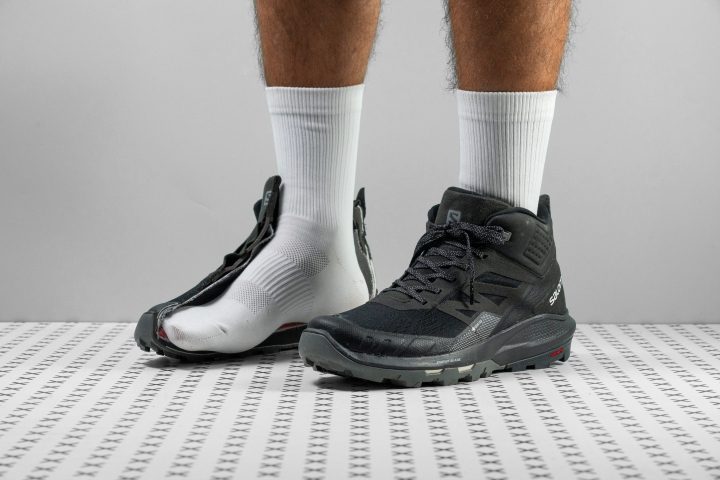











































What makes it the best?
We put on our lightweight waterproof boots in search of the best speed hiker. And no doubt, it’s Salomon’s Outpulse Mid GTX. It bridges the gap between hiking and trail running with its light build and natural sensation. We feel very agile in this pair as it takes us to greater speeds beyond our imagination.
We felt like the fastest hikers despite wearing boots. It feels more like a shoe with its 13.6 oz (386g) weight. It’s hard to ignore how significantly lighter it is than the average hiking boot (18.4 oz/521g). Further boosting our speed is the TPU Energy Blade that lies in the midsole for efficient power return with less effort.
We can adapt and navigate tricky terrains since the low stack gives us good ground feel. We measured the foam at 30.2/21.5 mm in the heel and forefoot vs. the 35.7/23.2 mm average. Despite this, the platform feels comfortable for long hikes. Our durometer confirms its velvet touch, standing 25.4% softer than average.
Even if we cross river streams or get caught in the rain, the GTX membrane keeps us dry. Under our microscope, we saw how tightly woven the material is, effectively keeping cold air and water out.
With its emphasis on lightness, Outpulse isn’t supportive enough for technical terrains and heavy backpacking. We recommend exploring other options for tougher hikes.
Pros
- Astonishingly light
- Comfy like a sneaker
- Excellent waterproofing
- Very durable build
- Soft and springy cushioning
- Low-to-the-ground platform
- Remains soft and flexible in cold weather
Cons
- Loose collar fit
- Not for technical terrain
Best lightweight waterproof hiking boots for urban hiking
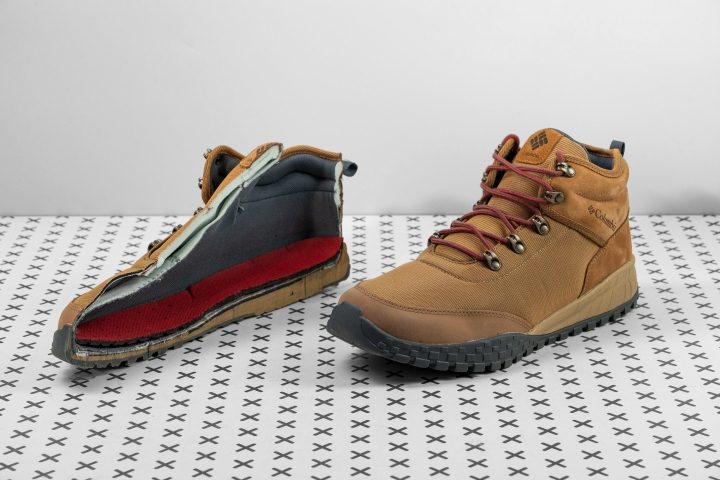



























What makes it the best?
A snazzy boot that doesn’t look out of place in the city or on the trail, the Columbia Fairbanks Mid is our top choice of lightweight, waterproof hiking boots on the urban hiking scene. The natural feel due to its low weight and incredible flexibility makes it a superbly comfortable boot for hikes around town. It’s low-profile but grippy outsole is perfect for asphalt and moderate gravel paths, and full waterproofing prevents soaked toes in unexpected downpours.
There is nothing clunky about the Columbia Fairbanks Mid. At just 15 oz (425g), it is an impressive 3.9 oz (112g) lighter than the average waterproof hiking boot, which helps it to blend in around the city. We feel equally comfortable out hiking or walking to the pub!
We experience an incredibly natural feel in this boot, almost as if we’re not wearing a boot. In the lab, we bent the boot to 90° with a force gauge, and were amazed to find the Fairbanks Mid is a whopping 58% more flexible than average! It’s no wonder our strides felt so free and easy!
The 3.5 mm lugs are 1 mm shallower than average, but we found this to be plenty for moderate surfaces on our urban hikes, even in the rain. The densely woven fabric upper keeps our feet warm and dry while splashing through puddles.
We measured the midsole with a durometer, finding it to be an astounding 29% softer than average. While this makes for a comfortable boot, we found it wasn’t supportive enough for carrying heavy loads. Therefore, we don’t recommend the Columbia Fairbanks Mid for long hikes with heavy pack loads.
Pros
- Remarkably light
- Head-turning looks
- Excellent waterproofing
- Good grip on mild terrain
- Hard-wearing outsole
- Soft cushioning
- Flexible design
- Fits as expected
Cons
- Not a true hiking boot
- Lacks support and stability
Best budget lightweight waterproof hiking boots








































What makes it the best?
Light in the pocket and on the feet, we found Merrell’s Moab Speed Mid GTX as the best budget boot in the lightweight waterproof category. At only $160, it’s 9.6% less than what we’d ordinarily invest in a hiking boot but it offers so much more than its price. It has unmatched lightness, cozy comfort, and reliable protection, which our feet truly enjoy.
It feels more like a trail shoe on foot, and our scales confirm it’s only 11.7 oz (332g), 34.1% lighter than the average boot. Together with the propulsive midsole, it encouraged our nimbleness and strong pace in the trails.
We tested the Gore-Tex upper in damp conditions, and it effectively kept our feet safe and dry. This boot is all about protection with its tightly-knit upper keeping debris away. Not only that, its platform ensures our safety from landing impact and unwanted elements underfoot. The cushioning spoiled our feet to a heavenly delight, measuring 26.2% softer than average per our durometer.
We also found the boot to have steady ankle support and a reliable grip that allows us to tackle the trails in a confident and surefooted manner.
We only wished for its laces to stay locked down. But once it’s secured, we’re good to go.
Pros
- Instant comfort
- Extremely light
- Unrelenting collar
- Mighty ankle support
- Grippy outsole
- Propelling boot
- Watertight
- Comfy all year round
Cons
- Not ideal for backpacking
- Unruly laces
What to expect from lightweight waterproof hiking boots
Rather than the obvious (them being lightweight and waterproof), these boots don’t feel bottom heavy as some other boots do that weigh more. Hikers believe that the price they have to pay is heavyweight, so these shoes go on to deny that. That’s why these boots are great for speed hiking in wet conditions.
However, the price they do pay for being lightweight is not having insulation, which makes them not best for very cold weather.

Hiking boot with no insulation cut in half in RunRepeat lab
Criteria for lightweight waterproof hiking boots
For a hiking boot to be considered a) lightweight and b) waterproof, according to our criteria, it has to weigh less than 17.6 oz (or 500g) and be, well, waterproof.
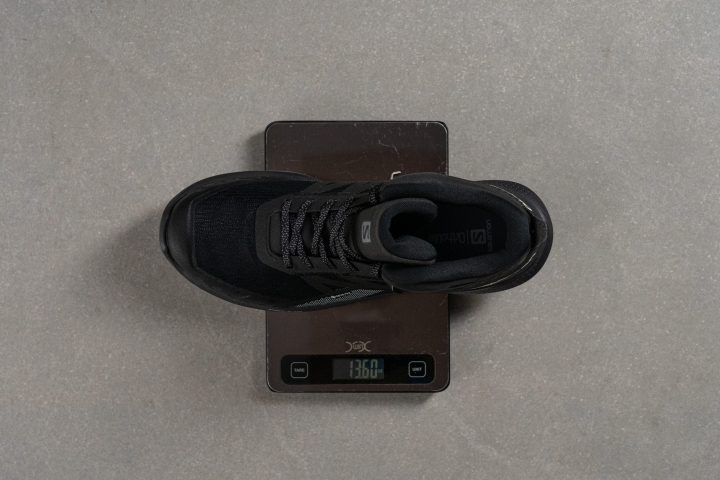
Lightweight waterproof hiking boot on a scale
Before we cut a boot in half and subject it to dozens of lab tests, we weigh it on the scale in our lab. Thanks to this, we always present a precise weight of hiking boots and, yes, it tends to deviate from what the brand has stated.
For context, at the moment of writing, the average weight of all hiking boots was 17.7oz or 503g, while the average weight of waterproof hiking boots was 18.5oz or 526g.
When it comes to waterproofing, we wear-test the boots to ensure that the waterproof membrane works, but we also look at the laminated materials once the boot is cut in half to see the area covered with the membrane.
We also test the breathability of the boot which indirectly tells us how waterproof it is.
Learn to recognize waterproof hiking boots
The most popular waterproof material used in hiking footwear is Gore-Tex or GTX. It’s also widely used in outdoor apparel. Its logo is easy to recognize and is always found on the upper of the hiking boot, the boot box and (almost always) in the boot name.

Noticeable Gore-Tex logo on hiking boots
However, this is not the only waterproof material. Some brands develop their own technologies and, if not familiar with those specific names, it’s best to check the name of the boot model or the box/specifications, they always mention the waterproof membrane if it is present.
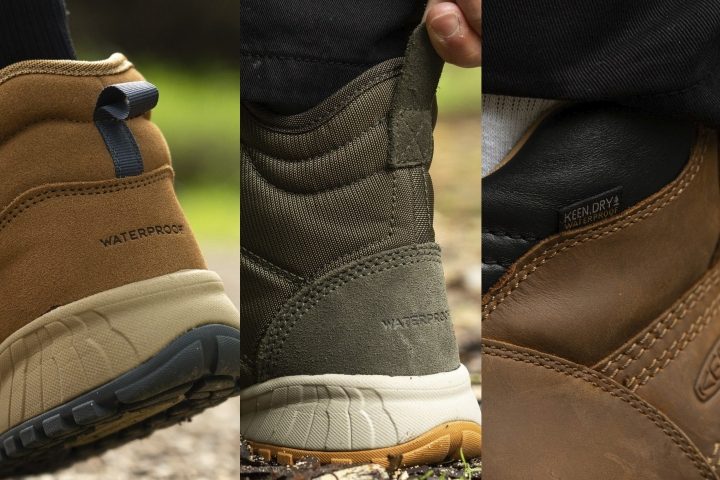
Non-GTX waterproof options in hiking boots
You may have already seen KEEN.Dry waterproof membrane present in KEEN hiking footwear, or Columbia’s Omni-Tech, or DannerDry waterproof material developed by Danner.
Not breathable = Waterproof
While many brands claim that their waterproof membranes are breathable, our experience has shown the opposite. Both on the test hikes and in the lab.
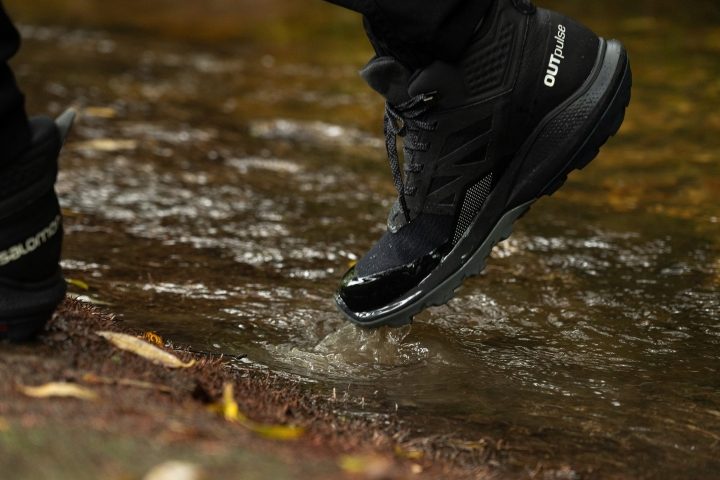
When people hike, the amount of sweat in the boots depends on:
- their feet and how much they naturally sweat,
- the type of socks they chose for that occasion,
- the weather conditions,
- and finally, the boot.
To have an objective approach, we standardized a breathability test. We pump smoke from our smoke machine into the boot and watch where the smoke comes out, when, and at which pace. In breathable hiking boots, we see smoke coming from the sides and the toe box. In non-breathable hiking boots, it doesn’t come out, or it does, but through the eyelets, or it finds holes around our smoke machine pipe.
Non-breathable waterproof hiking boot (right) vs. breathable non-waterproof hiking boot (right)
This happens because of the laminated waterproof membrane that we mentioned above and because the materials used in these boots are more dense or tightly woven. We know that because we look at every upper under the microscope.
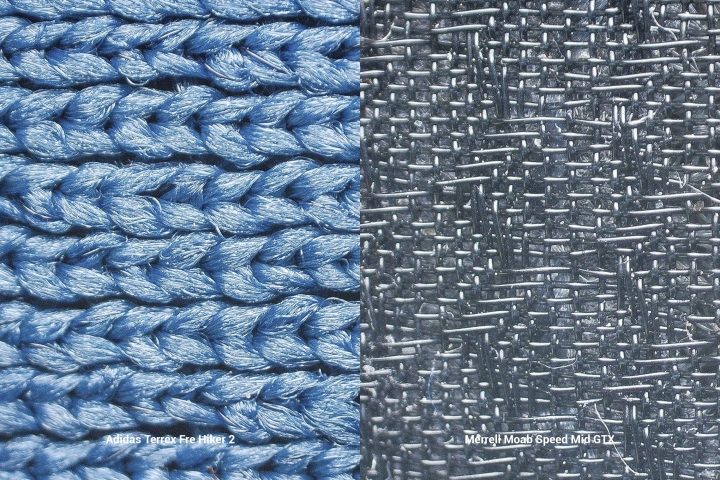
Non-waterproof upper (left) vs. waterproof upper (right) as seen under the microscope in RunRepeat lab
Slippery terrain asks for extra grip!
Before deciding which hiking boots you need, it’s important to know what type of the terrain you plan to cover. Just because it is wet, does not mean there’s one tread pattern or lug depth or outsole hardness that will do it all.
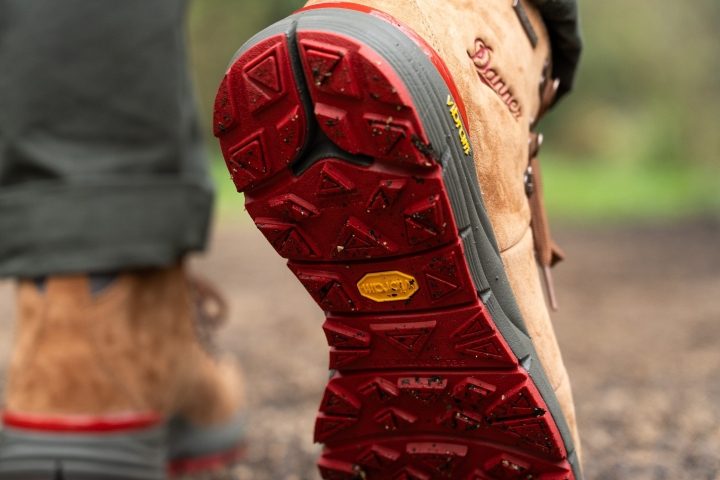
- For large flat rocks, we recommend shallow-to-average lugs (up to 4mm).
- For doing a bit of everything yet nothing too extreme, we recommend average lugs (~4mm).
- For mud, slush, snow, we recommend deep lugs (4mm and thicker).

Measuring the thickness of lugs in hiking boots using a digital caliper
In our lab, we measure the thickness of lugs using a caliper. But, we don’t stop there. Because softer rubber has shown to be more pliable and sticky, and harder rubber has proven to be more protective, we also test the hardness of the outsole rubber.

Using a shore C durometer to measure the hardness of the outsole rubber in waterproof hiking boots
With all these in mind, here are the test results to keep in mind when talking about grip in wet weather:
Keep it stable when hiking in wet conditions
When looking at the hiking boots, they can have a taller and narrower base and they can have a lower and wider base. We recommend the latter for more stable feel when hiking, especially in wet weather.
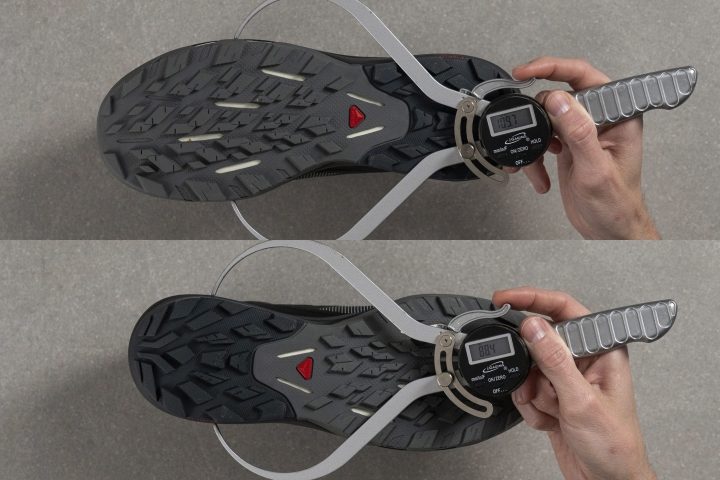
Midsole width measurements: at the forefoot (up) and at the heel (down)
When doing the tests in the lab, we also measure the width of the base of hiking boots. We measure it both at the forefoot and at the heel. The wider the base, the more stable the boot is!
We double-check this on our wear tests when we pay attention to the lateral stability of each hiking boot pair we test.
3 extra tips for hiking in wet weather
Water can still get into your boots even though they are waterproof.
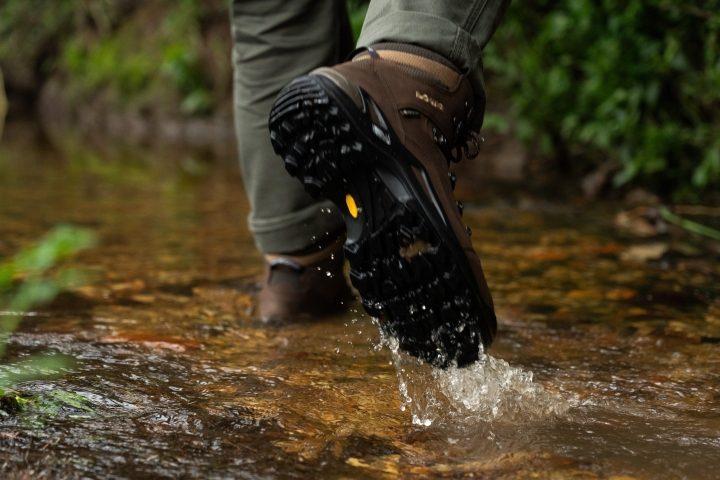
It can simply slide down your legs or trousers. And having water inside of waterproof boots is a nightmare. We recommend:
- Using waterproof knee-high gaiters. They offer that extra level of protection against water and it’s great that they also come in waterproof versions.
- Using wool or bamboo socks. They have moisture-wicking properties and dry quickly.
- Checking whether the boot has a gusseted tongue. Most of them do, but just to be sure. Gusseted tongues prevent the water/debris from getting inside the boot!

Gusseted tongue visible after the laces have been taken out
Do you REALLY need waterproofing?
Just because waterproof hiking boots are so bad at breathability, which also means that if the water gets in, it’s almost impossible for it to be evaporated out, you might want to consider lower levels of protection against water.
| Water-resistant | Water-repellent | Waterproof | |
| General characteristics | a tightly woven fabric that is naturally capable of resisting water upon contact | fabric treated with durable water-repellent (DWR) or hydrophobic chemicals | -fabric treated with DWR -have waterproofing membranes like Gore-Tex and OutDry -have seam-sealed construction for extra protection |
| Water protection level | low water protection | moderate water protection | high water protection |
| Water pressure resistance | 0-5000 mm (no pressure or moisture) | 6000-10000 mm (light pressure) | 10000-20000 mm (high to very high pressure) |
| Weather conditions best used in | light rain shower and dry snow | light rain and average snow | moderate to heavy rain and average to wet snow |
Nailing the fit in lightweight waterproof hiking boots
If this is your first time getting hiking boots, these are the steps we always recommend to be taken, to make sure the boots fit as well as possible:
- Go shopping later in the day, in the evening or late afternoon. We advise this because our feet are naturally swollen a bit by then. When hiking, our feet always swell, so it’s best to match those conditions and try the boots on then and there, and not when your feet are fresh.
- When you put the boot on, make sure you have 1 thumb’s width of space in front of your toes (the big toe, usually) when you glue the heel to the back.
- When the boot is laced up, sense if there are any hot spots. There shouldn’t be any. The boot should feel comfortably snug, not too wide, not tight.
- If trying the hiking boots in a specialized store, use the ramp to walk up and down over different artificial surfaces. Your heel should not be slipping and your feet should not be sliding to the sides.
That’s it.
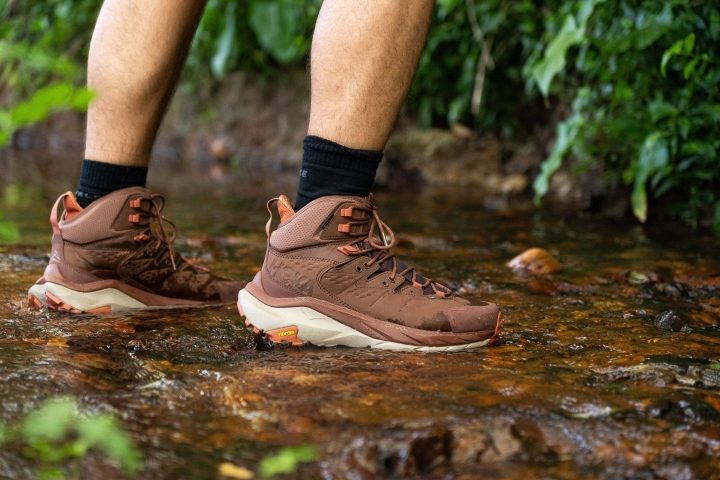
Before your first hike, especially if it is a longer one, make sure you break the boots in!

